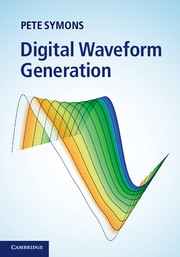Book contents
- Frontmatter
- Contents
- Preface
- Acknowledgements
- Glossary of terms
- 1 Introduction to waveform generation
- 2 The foundations of digital waveform generation
- 3 Recursive sine wave oscillators
- 4 DDS sine wave generation
- 5 DDS arbitrary waveform generation
- 6 Dynamic waveshape and spectrum control
- 7 Phase domain processing – DDS and the IDFT
- 8 Hardware implementation architectures
- 9 Digital to analogue conversion
- Index
- References
4 - DDS sine wave generation
Published online by Cambridge University Press: 05 November 2013
- Frontmatter
- Contents
- Preface
- Acknowledgements
- Glossary of terms
- 1 Introduction to waveform generation
- 2 The foundations of digital waveform generation
- 3 Recursive sine wave oscillators
- 4 DDS sine wave generation
- 5 DDS arbitrary waveform generation
- 6 Dynamic waveshape and spectrum control
- 7 Phase domain processing – DDS and the IDFT
- 8 Hardware implementation architectures
- 9 Digital to analogue conversion
- Index
- References
Summary
In this chapter we investigate DDS sine wave generation as an introduction to a general discussion of DDS arbitrary waveform generation in Chapter 5. We begin by reviewing phase accumulation frequency synthesis, discuss considerations for demonstrating sinusoidal DDS behaviour through computer simulation and finally review several important sinusoidal phase–amplitude mapping techniques. Relative performance is illustrated using simulated SNR, SFDR and amplitude spectra as a function of key control and design parameters. We focus on phase truncated wavetable indexing and introduce linear phase interpolation as an error reduction mechanism that gives near-optimal performance in most practicable applications (i.e. SNR and SFDR comparable to or better than amplitude quantisation noise).
Optimal sinusoidal phase–amplitude mapping with practicable wavetable lengths is accomplished with a technique that we call trigonometric identity phase interpolation. This technique uses the trigonometric angle summation identity to compute a phase–amplitude mapping whose SNR and SFDR are bound only by quantisation noise. Although computationally more costly than linear interpolation, this technique is easily adapted to generate exactly quadrature sinusoids with optimal SNR and SFDR. A reduced multiplication implementation is also possible that trades multiplication for addition operations and is presented in Chapter 8. The principal utility of this technique is in applications which require optimal SNR and SFDR performance simultaneous with phase offset control precision bounded by the phase accumulator resolution.
Information
- Type
- Chapter
- Information
- Digital Waveform Generation , pp. 109 - 161Publisher: Cambridge University PressPrint publication year: 2013
